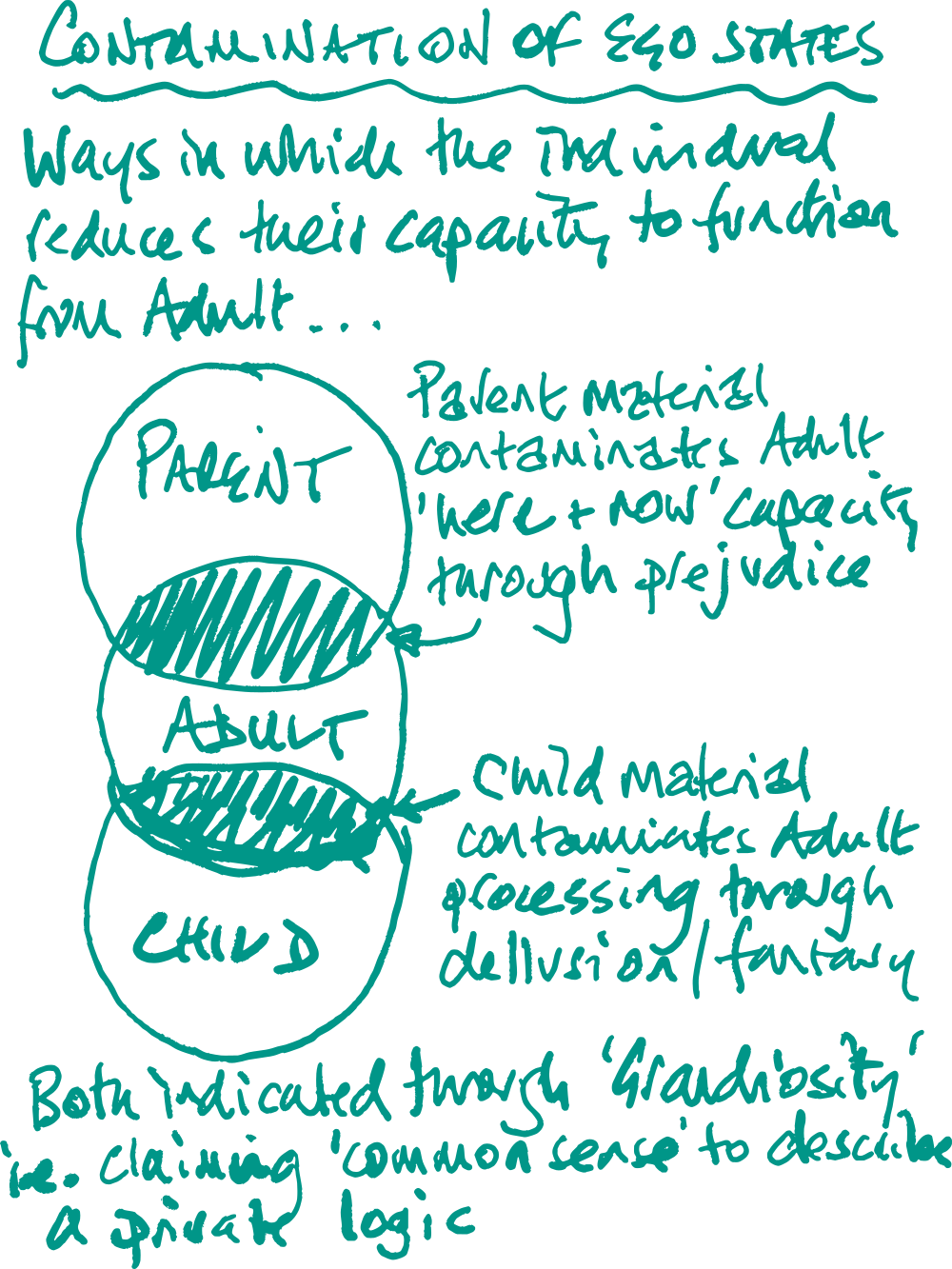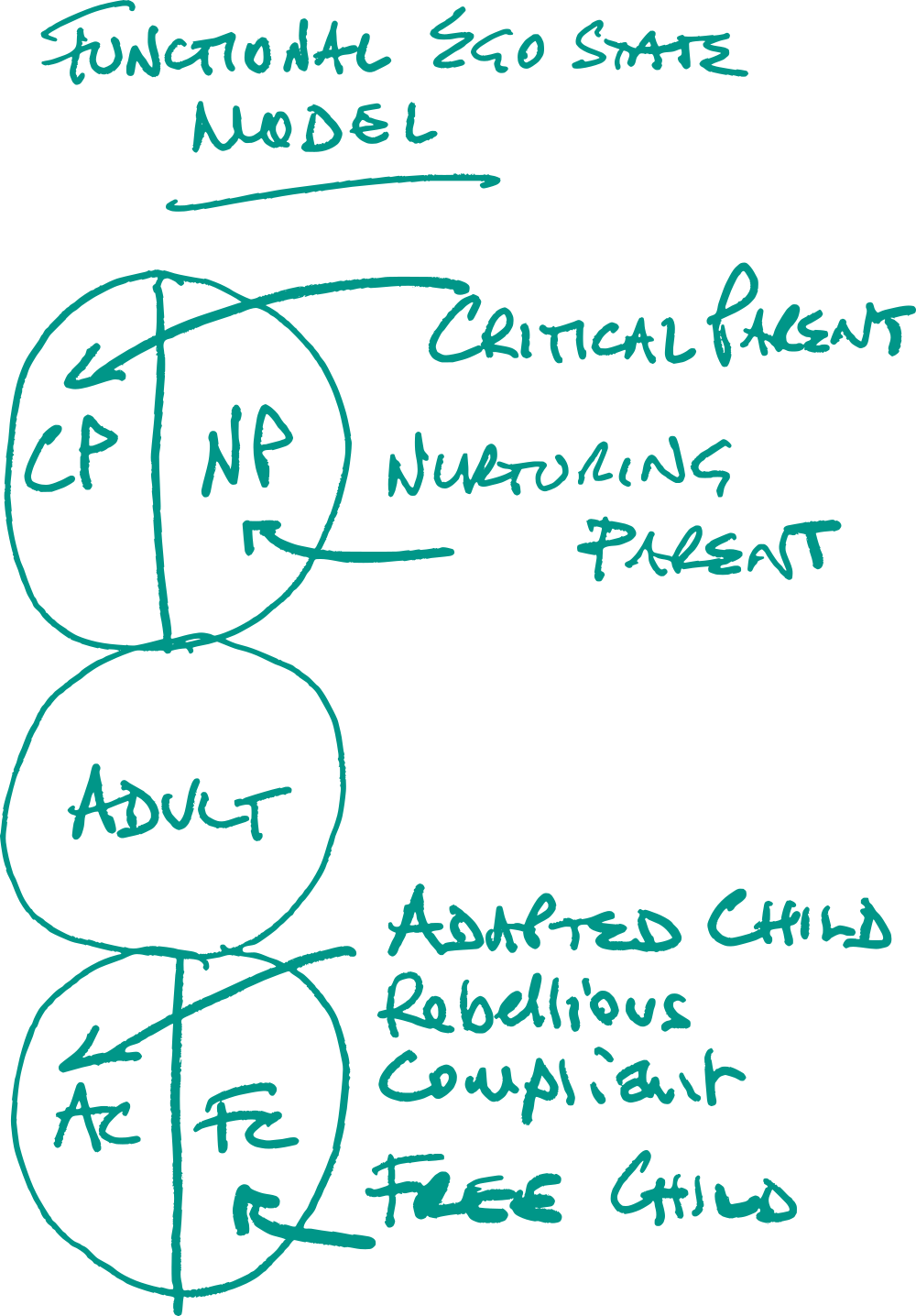Ego States

Eric Berne defined ego states as consistent patterns of thinking, feeling and experience directly related to corresponding patterns of behaviour. He said that everyone has three recognisable sets of ego states which he called Parent, Adult and Child.
In TA the ego state model is drawn using stacked circles and the structural and functional models are illustrated on the following pages. The words are written with an initial capital letter to denote the ego state from parents, children and adults. The structural ego state model describes the content of the individual and the functional model indicates what we do with the content:
STRUCTURE - CONTENT = WHAT IS THERE
FUNCTION - PROCESS = HOW WE USE IT
In the TA literature there are differences in how writers have further developed Berne’s original models. Refrences to the Little Professor, Free Child, using additional terms of the Adapted Child including Rebel and Compliant Child can also be found.
A dimension of ego state theory is the process of identifying ego states. This is important because we can increase our effectiveness in transactions and bring out the best in ourselves, and others. There are four ways of diagnosing ego states:
-
Behavioural diagnosis
By observing the words, gestures, tone and manner of an individual we can make some guesses as to which ego state a person is using, (see Table). -
Social diagnosis
By checking out our own and others’ reactions to an individual we may recognise their ego state. For example if we feel rebellious or compliant this may indicate that the other person is in their Parent ego state. -
Historical diagnosis
Through which it is possible to talk through patterns of how an individual’s current behaviour is typical of themselves in the past (Child clues) or people around them (Parent clues). We can also decide to do this to increase our personal self awareness. -
Phenomeonological diagnosis
Where a person is encouraged to disclose how they experience themselves in the moment, by asking for example, ‘How old are you right now?’
These are the ways which are most available to educators. In the therapy process it may also be possible to diagnose ego states by:
Contamination
Contamination is where the content of either or both Parent and Child ego states impair the capacity of the individual to fully operate from the Adult ego state. Like barnacles on a ship’s bow, contamination gets in the way of making clear progress in the here and now.
Functional Ego States
Berne referred to the structural egostate model to describe the content of the personality and then introduced a different model to describe how this material manifests itself in terms of function, ie. what it looks like. The functional ego state diagram has been presented in slightly different ways over the years. The model below is taken from the original work by Berne.
Functional Behaviours
The functional ego state can be seen in action through observable behaviours. Examples of these patterns can be seen in the table here.
Being in Adult
First it is critical to bear in mind that maintaining Adult aware ness takes time to practice and mindful, conscious effort – it rarely ‘just happens’. So, when starting out using TA intentionally it is worthwhile tracking the extent to which we find and stay in Adult over a period of just a day, at first, or for a specific situation.
Second, some top tips for being in Adult;
Practice becoming increasingly aware of when being in Adult is a challenge. For most of our time we may simply be ourselves and in doing so encounter little difficulty in being in positive and effective relationship. However, we may be acutely aware of times and situations where it is difficult to do so. Raising self-awareness is a crucial first step.
When you are in a situation where being in Adult is challenge it can be worth asking ourself ‘How old do I feel I am right now?’ Often if we are experiencing a high level of needing t adapt, ie. to do as we’re told or rebel, its likely that we’ll be very young.
On the other hand, if we’re experiencing a high sense of indignation or outrage it may be worth listening for any internal Parent material that oblige us to be outraged.
The main strategy for shifting into Adult is a combination of identifying options and considering which is the most appropriate in the here and now situation. This may sound obvious enough but it is surprising how challenging this can be. For example, one aspect of the reality is that we are angry or worried. A here an now option is to let people know that, but often Parent and Child material conspires so that we avoid letting others know important information and we demonstrate a different behaviour/feeing.
Finally, go find and observe those who tend to demonstrate a sustainable level of Adult functioning. Notice not just the language they use but also their tone, body language and general attitude. Its not useful to copy them – its valuable to have a picture to hold of what it looks like. The tendency is to use phrases such as;
- 'I am interested in...'
- 'You say that and I am a curious about...'
- 'So, I notice that I get irritated when that happens...'
- 'I am frustrated about the lack of progress in this meeting/discussion/lesson. I need to know what your view is...'
- 'I think you need ot know that I am angry about what’s going on here...'
- ‘I am apprehensive about this presentation – there are some things I need you to know so that I can help you get the best from this session...'
- ‘What might you be most interested in...'
The underlying message throughout is an acceptance that for the most of the time things are uncertain, even though we don’t want them to be. Marshalling our internal process about the uncertainty is the basic quality of Adult awareness.
Third, much has been written about the Adult egostate and one of my favourite writers on the subject is Keith Tudor who writes;
‘an expansive Adult ego state which characterises a pulsating personality, processing and integrating feelings, attitudes, thoughts and behaviours appropriate to the here-and-now – at all ages from conception to death. This present-centred state of the ego has the ability and capacity to act autonomously… to laugh, have fun and be silly, to learn, to develop and maintain a critical consciousness, to aspire, to express ambivalence and disappointment, to have a sense of community feeling, social justice, spirituality and much, much more. The… Integrating Adult describes the individual’s capacity to reflect upon and integrate their own archaic states as well as past introjects, and to draw on them in the service of present-centred relating...’ (Tudor, 2003 p. 201/202)
Tudor then provides a range of possible features of the integration;
-
Autonomy
The release of the human capacity for awareness, spontaneity and intimacy (and in a later addition – responsibility) -
Relational needs
For security, validation, feel affirmed and significant; for acceptance, for confirmation, for self-definition, to have an impact on others, to have another initiate and to express love -
Consciousness
Awareness of the individual brain and mind in relation to its environment -
Reflective consciousness
Being able to reflect on oneself, on the business of being human -
Critical consciousness
Tudor notes how the convention of splitting Critical Parent and Rebellious Child as negative the qualities associated with these tend toward the pathological and therefore unhealthy. Instead, he argues that these qualities have a legitimate part to play in being truly present-centred. - Maturity and motivation
-
Imagination
Because the individual is now free from contamination of fixated and introjected material they are free to accept, develop and respond to ideas previously prohibited


